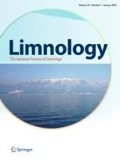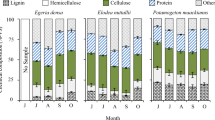Abstract
There are many problems related to overgrowth of aquatic macrophytes in many lakes and rivers throughout the world; for instance, the harvesting costs in Lake Biwa have been increasing by 200 million Japanese yen a year (equivalent to 1.8 million USD). Historically, aquatic macrophytes were harvested for use as fertilizer in agriculture in Japan, but are no longer in use because chemical fertilizers promote plant growth more effectively and are easier and cheaper to use. Thus, developing effective ways to utilize aquatic macrophytes is important to resolve this issue. In addition, sustainably harvesting macrophytes is also important for aquatic ecosystem management because macrophytes play a key role in aquatic ecosystems as nursery grounds and refuges for other small organisms living in the littoral area. Therefore, management and effective utilization of macrophytes through sustainable harvesting may play an important role in the conservation of lake ecosystems. In this short review, a recycling system using anaerobic digestion (AD) of submerged macrophytes, which were sustainably harvested from lakes, and microalgal mass culturing with AD effluent were introduced as a new technique for the conservation of lake ecosystems.

(courtesy of Otsu City Museum of History)

(courtesy of Dr. Eiso Inoue)

(courtesy of Dr. Eiso Inoue)

Similar content being viewed by others
References
Abbasi SA, Nipaney PC, Schaumberg GD (1990) Bioenergy potential of eight common aquatic weeds. Biol Waste 34:359–366
Appels L, Lauwers J, Degréve J, Helsen L, Lievens B, Willems K, Van Impe J, Dewil R (2011) Anaerobic digestion in global bio-energy production: potential and research challenges. Renew Sustain Energy Rev 15:4295–4301
Asada S (2012) Treatment methods for overgrowing aquatic weeds. Public Works Manag J (November issue):74–78 (In Japanese)
Barton BA, Taylor BR (1996) Oxygen requirements of fishes in Northern Alberta rivers with a general review of the adverse effects of low dissolved oxygen. Water Qual Res J Canada 31:361–409
Canfield DE Jr, Shireman JW, Colle DE, Haller WT, Watkins CEII, Maceina MJ (1984) Prediction of chlorophyll a concentrations in Florida lakes: importance of aquatic macrophytes. Can J Fish Aquat Sci 41:497–501
Carpenter SR, Lodge DM (1986) Effects of submerged macrophytes on ecosystem processes. Aquat Bot 26:341–370
Carrere H, Antonopoulou G, Affes R, Passos F, Battimelli A, Lyberatos G, Ferrer I (2016) Review of feedstock pretreatment strategies for improved anaerobic digestion: from lab-scale research to full-scale application. Bioresour Technol 199:386–397
Chandra R, Takeuchi H, Hasegawa T (2012) Methane production from lignocellulosic agricultural crop wastes: a review in context to second generation of biofuel production. Renew Sustain Energy Rev 16:1462–1476
Chen M, Tang H, Maa H, Holland TC, Simon Ng KY, Salley SO (2011) Effect of nutrients on growth and lipid accumulation in the green algae Dunaliella tertiolecta. Bioresource Technol 102:1649–1655
Collos Y, Harrison PJ (2014) Acclimation and toxicity of high ammonium concentrations to unicellular algae. Mar Pollut Bull 80:8–23
De Pauw N, Morales J, Persoone G (1984) Mass culture of microalgae in aquaculture systems: progress and constraints. Hydrobiologia 116(117):121–134
Dominguez-Bocanegra AR, Legarreta IG, Jeronimo FM, Campocosio AT (2004) Influence of environmental and nutritional factors in the production of astaxanthin from Haematococcus pluvialis. Bioresource Technol 92:209–214
Fernandes TV, Klaasse Bos GJ, Zeeman G, Sanders JPM, van Lier JB (2009) Effects of thermo-chemical pre-treatment on anaerobic biodegradability and hydrolysis of lignocellulosic biomass. Bioresource Technol 100:2575–2579
Food and Agriculture Organization of the United Nations (2002) Management of problematic aquatic weeds in Africa. FAO efforts and achievements during the period 1991–2001
Garcia-Malea Lopez MC, Del Rio Sanchez E, Lopez JLC, Fernandez FGA, Sevilla JMF, Rivas J, Guerrero MG, Grima EM (2006) Comparative analysis of the outdoor culture of Haematococcus pluvialis in tubular and bubble column photobioreactors. J Biotechnol 123:329–342
Grima EM, Sevilla JMF, Fernández FGA (2009) Microalgae Mass Culture Methods. Wiley Online Library. https://doi.org/10.1002/9780470054581.eib418
Haga H (2015) Historical change and recent extraordinarily luxuriant of submerged macrophytes in the sourth basin of Lake Biwa. J Environ Conserv Eng 44:482–487 (In Japanese)
Haga H, Ishikawa K (2011) Spatial distribution of submerged macrophytes in the southern basin of Lake Biwa in the summer of 2007, in comparison with that in 2002. Jpn J Limnol 72:81–88 (In Japanese)
Haga H, Ishikawa K (2014) Spatial distribution of submerged macrophytes in the south basin of Lake Biwa in the summer of 2012, compared with 2002 and 2007. Jpn J Limnol 75:107–111 (In Japanese)
Hamabata E, Sugimura S, Ishikawa K (2012) The explosive development and control of aquatic weeds. In: Kawanabe H, Nishino M, Maehata M (eds) Lake Biwa: interactions between nature and people. Springer, Tokyo, pp 469–472
Hilt S, Gross EM (2008) Can allelopathically active submerged macrophytes stabilize clear-water states in shallow lakes? Appl Ecol 9:422–432
Hiratsuka J (2011) Aquatic weeds harvester in Lakes Naka-umi and Shin-ji-ko, and Sato-umi system. In: In-nami T (ed) Nature and life in Sato-umi. Past, present and future for resources in oceans and lakes. Mizunowa-Shuppan, Yamaguchi (In Japanese)
Hiratsuka J, Yamamuro M, Ishitobi Y (2006) History for Sato-umi and Moku-tori, under-water world 50 years ago. Seibutsu Kenkyu-sha, Tokyo (In Japanese)
Hussner A (2012) Alien aquatic plant species in European countries. Weed Res 52:397–406
Hussner A, Windhaus M, Starfinger U (2016) From weed biology to successful control: an example of successful management of Ludwigia grandiflora in Germany. Weed Res 56:434–441
Hussner A, Stier I, Verhofstad MJJM, Bakker ES, Grutters BMC, Haury J, van Valkenburg JLCH, Brundu G, Newman J, Clayton JS, Anderson LWJ, Hofstra D (2017) Management and control methods of invasive alien freshwater aquatic plants: a review. Aquat Bot 136:112–137
Ishikawa K, Okamoto T (2015) Water quality in south basin of Lake Biwa and prolific growth of submerged macrophytes. J Environ Conserv Eng 44:488–493 (In Japanese)
Ishikawa K, Haga H, Inoue E, Ban S (2018) A basis for guidelines to control excessive submerged macrophytic growth to benefit ecosystem health and biodiversity. Limnology
Jeppesen ET, Lauridsen L, Kairesalo T, Perrow MR (1998) Impact of submerged macrophytes on fish-zooplankton interactions in lakes. In: Jeppesen E, Søndergaard M, Søndergaard M, Christoffersen K (eds) The structuring role of submerged macrophytes in lakes. Springer Verlag, New York, pp 91–114
Ji F, Liu Y, Hao R, Li G, Zhou Y, Dong R (2014) Biomass production and nutrients removal by a new microalgae strain Desmodesmus sp. in anaerobic digestion wastewater. Bioresour Technol 161:200–207
Kawanabe H, Nishino M, Maehata M (2012) Lake Biwa: interactions between nature and people. Springer, Tokyo
Kawasaki T (2015) Challenges to adaptive management and effective utilization of waterweed in Lake Biwa. J Environ Conserv Eng 44:500–505 (In Japanese)
Koyama M, Yamamoto S, Ishikawa K, Ban S, Toda T (2014) Anaerobic digestion of submerged macrophytes: chemical composition and anaerobic digestibility. Ecol Eng 69:304–309
Koyama M, Yamamoto S, Ishikawa K, Ban S, Toda T (2015) Enhancing anaerobic digestibility of lignin-rich submerged macrophyte using thermochemical pre-treatment. Biochem Eng J 99:124–130
Kohzu A, Shimotori K, Imai A (2018) Effects of macrophyte harvesting on the water quality and bottom environment of Lake Biwa, Japan. Limnology. https://doi.org/10.1007/s10201-018-0556-0
Kuiper JJ, Verhofstad MJJM, Louwers Evelien L M, Bakker ES, Brederveld RJ, van Gerven LPA, Janssen ABG, de Klein JJM, Mooij WM (2017) Mowing submerged macrophytes in shallow lakes with alternative stable states: battling the good guys? Environ Manage 59:619–634
Lishawa SC, Carson BD, Brandt JS, Tallant JM, Reo NJ, Albert DA, Monks AM, Lautenbach JM, Clark E (2017) Mechanical harvesting effectively controls young Typha spp. invasion and unmanned aerial vehicle data enhances post-treatment monitoring. front. Plant Sci. https://doi.org/10.3389/fpls.2017.00619
Little ECS (1979) Handbook of utilization of aquatic plants. A review of world literature. FAO Fisheries Technical Papers No. 187. http://www.fao.org/docrep/003/X6862E/X6862E00.HTM. Accessed 25 January 2018
Manatunge J, Asaeda T, Priyadarshana T (2000) The influence of structural complexity on fish-zooplankton interactions: a study using artificial submerged macrophytes. Environ Biol Fish 58:425–438
Ministry of Land, Infrastructure and Transport (2010) New procedures for improving water quality using natural forces (In Japanese). http://www.mlit.go.jp/river/shishin_guideline/kankyo/suishitukaizen/shiryousyuu.pdf. Accessed 15 Jan 2018
O’Sullivan C, Rounsefell B, Grinham A, Clarke W, Udy J (2010) Anaerobic digestion of harvested aquatic weeds: water hyacinth (Eichhornia crassipes), cabomba (Cabomba caroliniana) and salvinia (Salvinia molesta). Ecol Eng 36:1459–1468
Orzi V, Scaglia B, Lonati S, Riva C, Boccasile G, Alborali GL, Adani F (2015) The role of biological processes in reducing both odor impact and pathogen content during mesophilic anaerobic digestion. Sci Total Environ 526:116–126
Persson L, Crowder LB (1998) Fish-habitat interactions mediated via ontogenetic niche shifts. In: Jeppesen E, Søndergaard M, Søndergaard M, Christoffersen K (eds) The structuring role of submerged macrophytes in lakes. Springer Verlag, New York, pp 3–23
Rabemanolontsoa H, Saka S (2012) Characterization of Lake Biwa macrophytes in their chemical composition. J Japan Inst Energy 91:621–628
Santos M, Anderson L, Ustin S (2011) Effects of invasive species on plant communities: an example using submersed aquatic plants at the regional scale. Biol Invasions 13:443–457
Schriver P, Bøgestrand J, Jeppesen E, Søndergaard M (1995) Impact of submerged macrophytes on fish-zooplankton-phytoplankton interactions: large-scale enclosure experiments in a shallow eutrophic lake. Freshw Biol 33:255–270
Shiga Prefecture (2012) Attempts for effective use of aquatic weeds in Lake Biwa (In Japanese). http://www.pref.shiga.lg.jp/d/saisei/files/mizukusa/files/yuukouriyou.pdf. Accessed 15 Jan 2018
Shiga Prefecture (2014) Effective measures for mowing macrophytes in Lake Biwa (In Japanese). http://www.pref.shiga.lg.jp/d/biwako/files/h25mizukusataisakujigyou.pdf. Accessed 15 Jan 2018
Shiga Prefecture, Ministry of Land, Infrastructure and Transport (2009) Report for effective factors on macrophyte growth (In Japanese). http://www.pref.shiga.lg.jp/d/biwako/files/kentoumatome.pdf. Accessed 15 Jan 2018
Takamatsu T, Nakata R, Yoshida T, Kawashima M (1985) Depth profiles of dimethylarsinate, monomethylarsonate, and inorganic arsenic in sediment from Lake Biwa. Jpn J Limnol 46:93–99
Verhofstad MJJM, Alirangues Núñez MM, Reichman EP, van Donk E, Lamers LPM, Bakkera ES (2017) Mass development of monospecific submerged macrophyte vegetation after the restoration of shallow lakes: roles of light, sediment nutrient levels, and propagule density. Aquat Bot 141:29–38
Verrier D, Roy F, Albagnac G (1987) Two-phase methanization of solid vegetablewastes. Biol Wastes 22:163–177
Wang L, Li Y, Chen P, Min M, Chen Y, Zhu J, Ruan RR (2010) Anaerobic digested dairy manure as a nutrient supplement for cultivation of oil-rich green microalgae Chlorella sp. Bioresour Technol 101:2623–2628
Xia A, Murphy JD (2016) Microalgal cultivation in treating liquid digestate from biogas systems. Trend Biotech 34:264–275
Xie S, Frost JP, Lawlor PG, Wu G, Zhan X (2011) Effects of thermo-chemical pre-treatment of grass silage on methane production by anaerobic digestion. Bioresour Technol 102:8748–8755
Xu W, Hua W, Denga J, Zhua J, Li Q (2014) Effects of harvest management of Trapa bispinosa on an aquatic macrophyte community and water quality in a eutrophic lake. Ecol Eng 64:120–129
Acknowledgements
We thank two anonymous reviewers for their constructive comments and suggestions for our manuscript. This study was supported by the Environment Research and Technology Development Fund of the Ministry of the Environment, Japan (4-1406).
Author information
Authors and Affiliations
Corresponding author
Additional information
Handling Editor: Jun Nishihiro.
Rights and permissions
About this article
Cite this article
Ban, S., Toda, T., Koyama, M. et al. Modern lake ecosystem management by sustainable harvesting and effective utilization of aquatic macrophytes. Limnology 20, 93–100 (2019). https://doi.org/10.1007/s10201-018-0557-z
Received:
Accepted:
Published:
Issue Date:
DOI: https://doi.org/10.1007/s10201-018-0557-z




